by Ariane ~ March 22, 2015
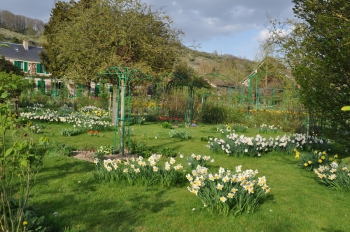
Monet’s house and gardens at Giverny will open next week on Saturday, the 28th of March 2015. If you plan to explore Monet’s place that early in the season, this is more or less what you can expect. The above pic was taken last year on the 2nd of April.
It is an effect I like and that doesn’t last for a long time, daffodils making bouquets on the fresh green lawn. Their planting recalls the way the water lilies float on the surface of the pond in Monet’s water garden.
In April it is still possible to look over the rose bushes planted all around this patch of lawn. Very soon leaves pop out, the border thickens and hides the lawn behind. In the meanwhile, the daffodils will have faded, so we will be only too happy not to see them anymore…
by Ariane ~ March 11, 2015
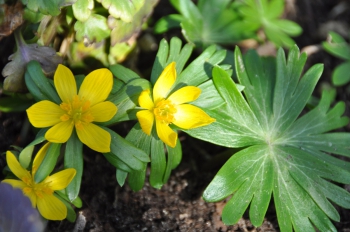 The first sunny days are warming up the soil of Giverny. In Monet’s gardens, the bravest flowers are popping out, most of them discreetly. Their bright petals make little dots of colors on the still bare ground. Pansies, snowdrops, crocuses, dwarf tulips and the first jonquils are a joy to look at. Among all these planted flowers, the eranthis impress by the carpets they make. Winter aconites are able to cover a curve of the pond bank, a nice place that will soon be shaded by tall trees.
The first sunny days are warming up the soil of Giverny. In Monet’s gardens, the bravest flowers are popping out, most of them discreetly. Their bright petals make little dots of colors on the still bare ground. Pansies, snowdrops, crocuses, dwarf tulips and the first jonquils are a joy to look at. Among all these planted flowers, the eranthis impress by the carpets they make. Winter aconites are able to cover a curve of the pond bank, a nice place that will soon be shaded by tall trees.
The eranthis is in a hurry because it needs to bloom, go to seeds and renew its food storage in its bulb in no time, that is to say before the leaves of the trees over it become too big. When the sun can’t shine through anymore, the leaves of the eranthis dry up and die. But not the plant itself! Life is stored underground, waiting patiently for three seasons to pass. Then, in February, the new shoots of eranthis appear, followed by the lovely yellow flowers in March, like miniature suns emerging from an interesting foliage. But with this plant the motto is ‘love it… and leave it alone’ because it is poisonous, just like the common aconite.
by Ariane ~ February 26, 2015
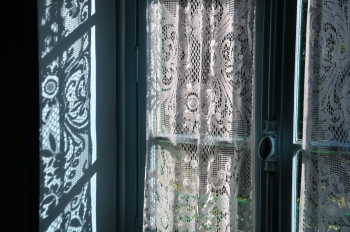
This picture was taken in one of the bedrooms of Monet’s home at Giverny. The house dates back to the mid-1800’s and most of the fixtures are still original, so I suppose this window handle is too. It is a very common model that can be seen in lots of houses of that time. Here it is painted the same pale blue as the window.
What is certainly much more recent are the curtains, although they look ancient and charming. But it is rare to find old curtains in good condition because the light and heat behind the window damage them rapidly. I suppose those were replaced at the restoration of the house in the 1970’s. They are machine made with sort of a floral pattern that resembles lace.
When I was a child I wondered. How can a curtain let us see through, but not enable people standing outside to peep in? Now I don’t any more. I take them for granted. A new surprise awaited me: I’ve realised since I work as a guide and chat with foreigners that curtains, especially lace curtains look french. Do you agree?
They also look country, in my opinion. I must confess that I am a big fan of the Country Living magazine, both the US and UK issues. It is very exciting to explore the country spirit overseas. To learn what people answer to the question ‘What makes my home country?’. Here the curtains would belong to these features. Monet’s house is at the same time a painter’s house, a house of the 19th century, the home of an upper-middle class family, and, being located in the country side, it is definitely a country house.
by Ariane ~ February 19, 2015
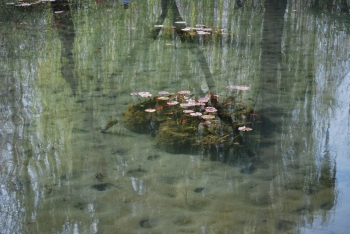
As long as the water is still cold, the algaes don’t feel like growing. They wait patiently for better times to come.
In March, the water of Monet’s pond is so clear that the bottom looks close, offering shamelessly all its details to the view.
The uneven surface of the layer of mud resembles the moon, with mysterious craters everywhere. The planters of water lilies pop up in this desert like a lunar buggy.
The brave first leaves have made their way through the water to reach the surface, looking for sun and energy. They are still purple but will soon turn green.
In back light, when the weather is fine, innumerable stars twinckle on the surface where the light kisses the water.
This crystal clear water is the show awaiting the first Giverny visitors. In April, days get longer, warmer, and the inviting sunbeams awake grass, flowers, trees and algaes alike.
Some years, the water looses its transparency and gets almost milky, to my delight, because I like the way it absorbs the colors, I find it lovely. After a while the water clears up again.
by Ariane ~ January 20, 2015
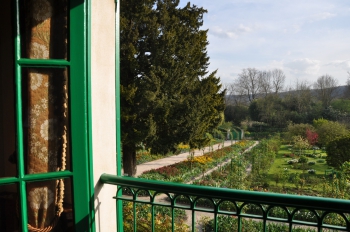 This is what Claude Monet could see when he gazed through his bedroom’s window in April. Last year spring was very early and the first colors were already there at the opening of the garden. Wallflowers make a striking effect combined with tulips, while daffodils and jonquils form islands of white and yellow flowers on the lawns. In the distance, the tall trees of the water garden don’t have any leaves yet. It is just a matter of days.
This is what Claude Monet could see when he gazed through his bedroom’s window in April. Last year spring was very early and the first colors were already there at the opening of the garden. Wallflowers make a striking effect combined with tulips, while daffodils and jonquils form islands of white and yellow flowers on the lawns. In the distance, the tall trees of the water garden don’t have any leaves yet. It is just a matter of days.
by Ariane ~ January 12, 2015
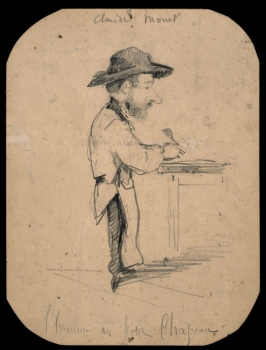
Claude Monet, ‘L’homme au petit chapeau’ (The Man in the Small Hat) 1855/56, Art Institute of Chicago.
Monet started his career as a caricaturist. The Art Institute of Chicago keeps one of his most ancient drawings, this man in a small hat made when he was 15 years old. Because the title is so vague and the drawing rather respectful, we can imagine that this young person may have been Monet’s school mate. Later on, Monet became more offending by drawing what was not yet called the people of Le Havre, as we say in French: the upper middle class bourgeoisie of his city.
I must say this is not the Monet I like best. But it reflects the impulsive and rebellious personality of the painter. Twenty years later, it was Monet’s turn to be mocked, when he dared show his avant garde paintings at the first impressionist exhibition in Paris.
This is how liberty goes. Monet and his friends opened new fields of liberty. The freedom to paint how I like, what I like. The freedom to exhibit and find buyers.
But Monet wanted more. Later on Monet still fought for the admission of Manet’s ‘Olympia’ in the state collections. He didn’t paint for a year to dedicate to this mission. He wanted public recognition of this new freedom.
In matter of politics, Monet was not the kind of artist that withdraws in one’s studio. He was friend with Zola and supported him during the Dreyfus Affair, because he felt things were not fair and had much to do with anti-semitism.
This is how he lived, secluded in the village of Giverny but reading the newspapers, keeping an eye on the world, speaking with Clemenceau.
Monet would have been Charlie.
by Ariane ~ January 4, 2015
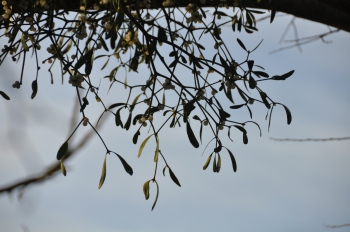
This picture was taken on January 1st at Giverny. Outdoors, under a mistletoe plant growing on a tree. Mistletoe is extremely common in our area and can be seen on a wide range of trees including poplars, apple trees, aspens or oaks.
As long as the leaves don’t hide it, mistletoe is very visible and puzzles many visitors. It is a parasite and it does kill the branches it grows on by being too greedy, but the tree itself generally resists. In the meanwhile, mistletoe offers bed and board to many birds. It is now considered an ecological keystone species.
As a guide, I was recently asked by a client if we also kiss under the mistletoe on New Year’s Eve. Actually, we do sometimes, although I doubt this habit belongs to the French folklore. But because we love kissing in France, any excuse for it is immediately adopted, of course. However to tell the truth, the clock striking midnight is enough to start the kissing party.
I wish you many opportunities for kissing this year and twelve months full of love, friendship and warmth. Have a wonderful year 2015!
by Ariane ~ December 27, 2014
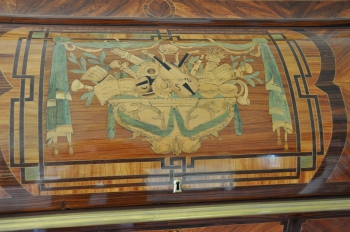
Here is a close-up of the desk that can be seen in Claude Monet’s bedroom at Giverny. It is from the mid 18th Century and features music instruments, not painting material. It was already an antique when Monet purchased it.
During the second half of his life Monet became famous. Recognised as a great painter, he sold his paintings at high prices. This enabled him to live a comfortable life.
The desk was restored last winter and found its original colors again.
by Ariane ~ December 5, 2014
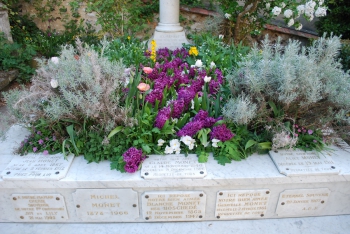
Claude Monet is buried at Giverny. His grave is located behind the church. It’s a 10 minute walk from his house.
It is a big family tomb planted with flowers, what sounds only natural for such a great gardener. Monet rests together with his second wife Alice, his two sons Jean and Michel and their wives. Susan, a daughter of Alice, and Alice’s first husband Ernest Hoschedé also keep Monet company. It is rather ironical that Monet and his rival rest in the same grave.
The reason is that Ernest was the first one to die, and his children -raised by Monet- wanted him to rest in Giverny to be able to go on their father’s grave easily. The next one to pass away was Susan. Logically, she was buried with her father. Alice never recovered from this latter grief. When she succumbed to leucemia, she joined her beloved daughter in her last residence. Next came Jean, Monet’s son, and Claude Monet himself. He died the 5th of December 1926 from lung cancer.
by Ariane ~ November 24, 2014
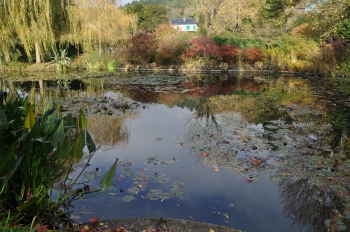
Fall atmosphere in Monet’s gardens at Giverny.
The picture was taken from the steps of the dock next to the water lily pond.
On the left, the green leaves of pontederias.
The red shrub on the opposite bank is a Japanese maple.
In the distance appears the pink house with green shutters, Monet’s home for 43 years.
On the right, through the branches, the third studio where Monet painted his biggest water lilies panels.
by Ariane ~ November 10, 2014

Do you want to have a look at the Monet Garden while it is closed for the winter?
Here is the Japanese bridge as it was this morning.
Giverny is now closed for five months.
The village will awake again next spring.
The first day for visiting the gardens will be Saturday 28 March, 2015.
by Ariane ~ October 22, 2014
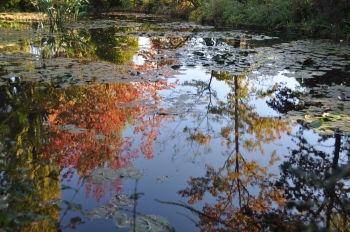
Yesterday I guided very charming hawaian guests at Giverny. It was nice to look at Monet’s gardens through their eye from Hawai. They reminded me that fall doesn’t exist on their island. It is summer all year round. Discovering the special spirit of this season sounded very exciting for them. Autumn has started to work its magic on the foliage. The three sweet gum trees reflect their reds and oranges into the water lily pond. For us, who know what will come next, this dramatic show of the saison, despite of its beauty, has a special flavour of nostalgia and melancholia intertwined.
by Ariane ~ October 8, 2014
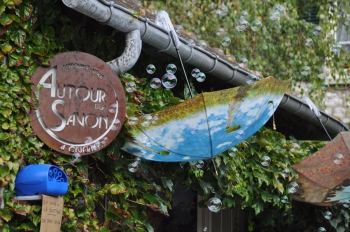
Impressionist umbrellas featuring ladies with a parasol that hang upside down from a gutter,
and soap bubbles flying through the air and catching all the colors of light,
this is also Giverny, the village of the French impressionist painter Claude Monet.
by Ariane ~ October 2, 2014
[singlepic id=258 w=350 h=350 float=left]Every last Sunday of September, the main street of Giverny “Rue Claude Monet” turns into a sidewalk sale. Hundreds of booths display a large range of used things, from antiques to books and toys. These so called Fairs to Everything (foires à tout) are extremely popular in the area of Giverny and attract thousands of visitors.
I photographed this paint box at the Giverny fair last week-end. It is a foldable one. I found it especially artful, if I dare say, because of the two little bumpers that prevent the two sides of the palet from sticking to one another when folded.
Below, the zinc box is partitioned to contain tubes of color and brushes, and a bottle of solvent.
Foldable means that the box was easy to carry outdoors for open air painting, the big revolution of the 19th Century. Thanks to the newly invented squeezable tubes of colors, artists were able to leave their studios and paint the landscapes they saw, generously lit by the sun.
I wonder whom this very paint box belonged to, and what paintings were made with it. The mystery contained in ancient objects is part of the fun we have going antiques hunting…
by Ariane ~ September 14, 2014
[singlepic id=257 w=320 h=240 float=left]
Early in the morning, the low sunbeams stroke the flowers at Giverny. Some mist still hangs in the air, like the dreams of the night. There is a feeling of awakening.
The little lanes of Monet’s garden look even more inviting. Early in the morning, minutes after opening time, the Clos Normand is still silent. One can hear the plants breathing, almost.
It is a magical moment that must be picked up quickly. Shortly later, the air will be full of voices, and the place full of people.











